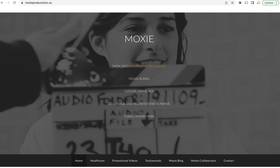|
Whether creating an educational, training or promotional video, or for that matter a television show or feature film, you have to start with a good SCRIPT. As the saying goes "IF IT'S NOT ON THE PAGE, IT'S NOT ON THE STAGE". Clearly, the script for a 45 second promotional video won't be as in depth and painstakingly long to write as a feature film script but the basics are the same. We will discuss the 4 basic steps to creating an engaging and effective script for whatever project you would like to undertake. #1- BE CLEAR AS TO WHAT YOU WANT TO SAY Sounds simple but not always easy. It is important to be very clear as to what exactly you are wanting to communicate to your audience. You can look at it as the THEME of your video. Are you attempting to teach your students a new technique, inform your clients of a new service or promote your business to new potential customers. Each dictates a direction the script hence the video will need to take. One way of ensuring you are clear as to what you want to communicate is to put it into one sentence, what in the film and television industry is called a LOGLINE (or elevator pitch). Examples: "Students will learn how to tell a patient they have cancer". "I want my clients to know we now offer online Pilates classes." If you notice, these log lines also take into count the # 2 basic step... #2- KNOW YOUR AUDIENCE All marketing depends on knowing your customers. In creating a script for your video, it's important to know your audience and that includes educational and instructional videos. A video for first year medical students communicates different information than a video aimed at medical residents. You must understand your audience (your customers, clients, staff, students) in order to deliver an effective and engaging video. Once you have what you want to say and to whom you want to say it, the next step is to ... # 3- CREATE AN OUTLINE The script outline is your map to navigate through your video. As you would if you were writing an essay or a blog post, list out your key points and order them logically. . Be sure to include a message near the beginning that states your video’s purpose, especially for educational and explainer videos. Remember, many people won't stick around to the end of the video if they are not grabbed by it within the first 10 seconds- so don't keep them guessing for too long. Important to keep in mind when writing your outline is the visuals that will go along with the dialogue. The visuals will definitely enhance what is being said and the best ones will negate the need for too much language. Below is an example of a video outline. #4- WRITE AND REWRITE YOUR SCRIPT Now that you have your outline, you can write the first draft of your script. Yes, first draft, as there will be many. An interesting piece of trivia is that M. Night Shyamalan wrote 10 drafts for the script of The Sixth Sense and there were no ghosts in the first draft! The real art of writing is re-writing. Pass on your script to someone else to read. Getting a second and third opinion is very helpful as they will possibly find holes in your script that you can not see. Once you have received feedback and re-written your script and you are feeling confident that it's ready to be filmed, organize a table read. A table read consists of everyone involved in the project both in front of and behind the camera gathered together to read the script out loud. This allows you to hear how conversational the dialogue is, and what can be cut. It's important that the dialogue sounds real and conversational and the only way to know is to have it spoken out loud. 99% of the time after a table read dialogue is changed or cut back. It's recommended to script every last word and have the on camera performers memorize it. Professional on camera personnel will be totally prepared and able to memorize their lines. Doing this will keep you organized during filming and save you loads of time (and money) later in post production. Example of a scenario based video script. Dialogue heavy. Learning point: recognizing microaggression. Example of a two column video script. This website uses marketing and tracking technologies. Opting out of this will opt you out of all cookies, except for those needed to run the website. Note that some products may not work as well without tracking cookies. Opt Out of Cookies
0 Comments
There are a number of components and elements to consider before venturing into creating a video. As always, the more prepared you are before you begin filming, the better your filming day will be and the more successful your video will turn out. To ensure the highest quality of video we always recommend hiring professional videographers, audio recordists and editors, in other words, a professional video production company. For those projects where budget is restricted and you have to go it alone, we hope that the following 8 Components will help you create an effective video. COMPONENT # 1 - VIDEO LENGTH We all live busy lives and have so much information coming at us that it's sometimes hard to find the time to read and watch everything we want to. And when we are on certain social media sites, we expect videos to be of a certain length and when they are longer, we tend to not watch them, at least not all the way through. It's important to keep the length of your video within the recommended time for the genre of video being created. Below is the recommended video lengths for various types of videos:
COMPONENT #2- KEEP THE MESSAGES CLEAR AND CONCISE It's clear that you don't have a lot of time to get your message across so it's important to keep your message clear and concise. That is why it's imperative, before you start filming, that you have developed a SCRIPT that outlines what you want to convey to your AUDIENCE. Everything else in your video will be driven by your script, notably duration, visual-content and call to action. The time and therefore money you will save both during filming and in post production (editing) will be correlated to the amount of time and energy went into your script. So be prepared before you begin filming. COMPONENT #3- SUPPORT YOUR SCRIPT WITH VIDEO A picture says a thousand words, and a moving pictures says 10 thousand! When creating your script think about the accompanying graphic imagery that will enhance the themes, keywords and actions in your script. Humans respond to other humans, therefore incorporating people in your videos is a wonderful way to grab and keep the viewers attention, as long as they compliment the script. COMPONENT #4- VIDEO DIMENSIONS Make sure the dimensions or your layout of the video adhere to the platforms you would like to upload your video to. Most professional editing software offer the different dimensions required for all social media platforms. It is something to be thinking about when filming your video. The dimensions will dictate the camera you chose, or which way you hold your smart phone when filming. And do remember to consider any captions or titles you want to add to your video and make sure you have room when filming around your subjects to add those in post. Below are some general dimension guidelines to follow:
COMPONENT #5- VIDEO AUDIO We have gone into more detail in another blog about audio, but it's so important that it requires repeating. Viewers will more likely abandon a video due to poor audio before they abandon it due to poor visual quality. Therefore make sure the narration and any background music are as clear as possible and of equal volume. There is nothing more frustrating than having to constantly be fiddling with the volume of a video when watching it because some things are too soft and others are too loud! Two important things to keep in mind regarding the audio quality of your video: quality of the mic you are using and the ambient sound. It is worth spending money on a good mic- it will save you money and aggravation in post- because remember many audio issues CAN NOT be fixed in post. COMPONENT #6- LIGHTING IN VIDEO As with audio, we have gone into video lighting in detail in our other blog, but it also bears repeating. The lighting requirements differ depending on the type of video you are filming and which platform you intend to post to. In general it's important to keep your subject well lit, and the more natural looking the better - especially for TikTok, and Reels. When creating explainer videos or training videos, using the 3 Point Lighting method is the best approach. COMPONENT #7 - EDITING THE VIDEO As anyone can tell you editing is where all the magic takes place and where your vision comes to fruition. Editing programs have made it easier to actually do the editing, but it takes skill and know how to do it well. Our suggestion is always to hire a professional editor- they will make magic out of your footage. And we understand that it's not always feasible to do so, therefore we hope the tips below will help you when you are editing your videos. Remember the aim is to explain your narrative in an engaging and entertaining fashion in the allowed time.
For the most part, editing should be smooth, allowing the viewer to absorb the thoughts without recognising that the scenes altered in any manner. Remember, rules were made to be broken and so your vision, content and script will dictate how you want your editing to look. COMPONENT #8- USE CAPTIONS Well over four-fifths of videos watched on Facebook are consumed without sound. This is why it's important to add captions to your videos. Moreover, captions allow videos to be accessible for a diverse audience. We at Moxie Productions can and will do everything in this article and more to produce the best videos for you and your audience. This website uses marketing and tracking technologies. Opting out of this will opt you out of all cookies, except for those needed to run the website. Note that some products may not work as well without tracking cookies. Opt Out of CookiesThe best way to create professional videos that look and sound great is to hire professional videographers and sound recordists. As you can see from the images below, they come prepared with the various tools of the trade. Their talent, experience and equipment does come with a price tag that is sometimes more than your budget allows or your project requires. If you are creating videos that are scenario based, with more than two people talking, I would always recommend hiring a professional video production company to film and edit the videos. The extra cost will pay off in the end with videos you can be proud of and will stand the test of time. In this blog we will be discussing video projects where there is one to two people speaking directly into camera. We call these 'talking head' videos: an interview-style video that features an instructor or subject matter expert who talks directly into the camera as though they are addressing the learner directly. This is the style used to great effect on Tiktok, Instagram, YouTube and Facebook. The best and least expense way to begin filming your talking head videos is to film them using whichever smart phone you have. (We will be discussing DSLR and Mirrorless cameras in another blog). The cameras on the phones are great for these types of videos and for where the videos will ultimately live. There is no need to shoot them on 4K cameras as the sites where you will be posting them don't support 4K videos. The two important things to consider when filming your videos are the audio quality and lighting quality. Let's talk lighting first. LIGHTING FOR TALKING HEAD VIDEOS Lighting can make anyone look good or bad! The most tried and true method to lighting for a talking head video is the 3 POINT LIGHTING METHOD. The three points are: KEY LIGHT: The key light is primary source of the scene. It is the most intense and direct light source which is used to illuminate the subject. The key light is most often placed in front of your subject, at an angle, and thus illuminates one section of your subject. Methods to Manipulate a Key Light:
FILL LIGHT: The fill light does exactly what it sounds like it does-it fills in gaps in light created by the key light. It eliminates shadows created by the key light and doesn't create any of it's own. It's less powerful than the key light and is placed opposite from it. The fill light determines the feel and style of the shot. What does fill light do?
BACKLIGHT/HAIR LIGHT: The backlight lights the subject from behind to help separate them from the background. It's generally placed higher than the subjec that it's lighting. When a backlight hits a subject at an angle it is referred to as a kicker or rim light. What is backlight used for?
Resourced image from https://www.videoschool.com/three-point-lighting/ Now that we know where to place the lights, the question is what type of lights should we be using? METHOD 1 - NATURAL LIGHTING This is exactly what it sounds like- the use of natural light for the KEY LIGHT. Perhaps your home, office or home office has a nice big window- perfect. You set up facing the window with the camera in front of you and use the natural light from the window as your key light. You can then use a reflector from the natural light as your FILL LIGHT and another reflector as your BACKLIGHT METHOD 2- LED LIGHTING KITS LED lights are lighter and cooler than other types of video lighting and can be plugged into any household outlet. LED’s are extremely efficient. You can use batteries to power them. That makes them portable and sleek - no messy cabled needed. Some suggested lighting kits: Neewer 660 LED Light Kit at Amazon GVM LED Video Lighting Kit at Amazon VILTROX VL-200 Kit at Amazon AUDIO FOR TALKING HEAD VIDEOS The sound of your video is crucial. We can forgive a wobbly camera or lighting that isn't perfect, but we can't forgive bad sound. People will turn off any video that has bad sound. The mic on most smart phones are good in perfect conditions ie; in a quiet room with no outside noise (street sounds, people in other parts of the office/house), or no inside noise (air conditioners, fluorescent lights, running refrigerators) and with a single subject. When another subject is added, or the conditions for filming are not perfect, the smart phone mics are not adequate. An external mic source is required.
AUDIO FOR TALKING HEAD VIDEOS The first thing to consider in terms of audio is location. There are two locations to consider: INSIDE and OUTSIDE INSIDE: Inside is the easiest place to shoot as there tends to be less noise to interfere with your video. Some things to consider when choosing an indoor location: 1- How busy is the location? The busier the location the longer it will take you to film and the more heartache you will have in post when you realise you can't use the footage due to noise issues. Unless you can lock down the whole building while you are filming, it's best to chose a location that is as isolated as possible. 2- How loud is the room? Yes, empty rooms can be louder than other empty rooms. Stand in the room you are planning on filming and listen for sounds like: air conditioners, fluorescent lights, fridges, elevator sounds, sounds emanating from outside like trucks. If the room is noisy, try to find another room. If you have to use a noisy room- at the end of your filming record 30 seconds of the room tone so that it can be used in post when cuts are made from one take to another. A good note to be on the safe side:if you can hear it, your phone can hear it, so stop and wait for the noise to end. OUTSIDE: Outside has many challenges when it comes to audio. Not only do you have to think about how busy your location is for the same reason as you do for when shooting indoor, you also have to take into consideration the weather, especially the wind. If you do not have a way to block the wind from your phone mic, your audio, and therefore your video, will be unusable. It is why, when filming outside, it is imperative to use an external mic with a wind sock. Some suggested External Mics Maono 2.4 GHz Dual Lapel Mics Sabine Tek Official SmartMike Saramonic Blink 500 More and more studies are showing that the addition of video to any curriculum enhances the learning experience for the learner. "One study of teaching methods found that telling alone, showing material visually alone, and combined telling and showing each resulted in 70% or greater recall at 3 hours (85% for combined). However, retention 3 days later was 10% for telling alone and 20% for showing alone, compared with 65% retention for combined telling and showing." Studies also show that the quality of the videos and the planning of the content are 2 very important aspects to the success of videos in education. The four principle reasons for the success of integrating videos into teaching are: 1 - ENGAGEMENT “Video is seen as having advantages for engagement in some specific ways, notably in widening participation, emotional engagement and overall course engagement.” Across the literature, higher levels of student satisfaction are reported in groups with access to video (Yousef et al., 2014). When comparing video over text when dealing specifically with problem- based learning it was found a general preference for video over text (Rasi and Poikela, 2016). 2- REAL LIFE EXPERIENCE Videos allow learners to watch and experience real life situations. Using video scenarios enables the assessment of impact by requiring learners to face realistic challenges and solve complex problems using critical thinking. “The integration of multimedia in the course gave students a collaborative experience where they can apply their knowledge to the simulation scenarios. Inclusion of the vignettes was found to be effective in addressing specific areas of curriculum while stimulating student engagement.” The greater the reality of the situation, the greater the emotional impact and the learning. Professional content writers and creators are able to make sure that the scenarios are real and impactful. 3- RETENTION One study (Taslibeyaz et al., 2017) in the context of medical education from 2000 to 2014, showed that watching videos was beneficial for gaining clinical skills, changing attitudes, encouraging cognitive learning and retaining knowledge. A review of the literature done by Maya M Hammoud, Helen K Morgan, Mary E Edwards, Jennifer A Lyon, and Casey White concluded “in general video recording of performance and subsequent review by students with expert feedback had positive outcomes in improving feedback and ultimate performance.” 4- LEARNERS WANT VIDEOS The following is an excerpt from the study “Development of e-learning in medical education: 10 years’ experience of Korean medical schools” by Kyong-Jee Kim and Giwoon Kim “Our study illustrates the current popularity of online videos as learning resources among medical students. This finding concurs with that of Khogali et al. that students valued animation and video demonstrations highest among e-learning resources.” It’s not only millennials who prefer videos. Business executives prefer watching videos, as well. Specifically, 59% of senior executives prefer video over text and 75% of executives watch videos while working. Creating videos for your course may seem daunting, but a professional video production company, like Moxie Productions, who specializes in educational videos, can guide you through the whole process. This website uses marketing and tracking technologies. Opting out of this will opt you out of all cookies, except for those needed to run the website. Note that some products may not work as well without tracking cookies. Opt Out of CookiesSo – you want to create a corporate, educational or promotional video but you’re a little overwhelmed. Where to start? You might only want a small in-house video, or you might want a large production that could take a couple of days of shooting. At Moxie Productions, our crews can be as small as two people, or consist of director, cinematographer, sound, continuity, makeup and several actors. It depends on what you need. We tailor your shoot to your specific requirements. Maybe you have a project that has a script already and what you need is film production. We can do that. Do you have footage shot in house that needs editing? We can do that too. Moxie Productions can come onto a project at whatever stage you require. So we’ve broken down the full process into five easy steps. Easy – for you. And to let you know what’s happening behind the scenes, we’ve included a little about the work we’re doing at every step to create your video exactly the way you want it. STEP 1- DEVELOPMENT Moxie Productions will meet with you to get an idea of what you want to say and who your target audience is. Together, we’ll decide on things like how long your ideal video will be and drill down into what you want and need to get across and how. We ask the questions, and use your answers as the building blocks to help us create the script – a script that you will always have final approval of. STEP 2 - PRE-PRODUCTION Here’s where the rubber really meets the road. Behind the scenes the work is really ramping up, and Moxie Productions will keep you in the loop every step of the way. But there are a lot of things involved in pre-production, like booking crew, actors and location, and rehearsing with those actors – this is where our expertise takes the logistical and creative burden off of you. Because there is a myriad of details to deal with at this stage, like setting the shooting schedule, creating a shot list, and assembling wardrobe, props and sets, just to name a few. The more things that are ironed out in pre-production the better the shoot day(s) will go! STEP 3 - PRODUCTION Lights, camera, action! Shoot days are what we all think of when it comes to making a video. Moxie Productions work with seasoned professionals to make the day go smoothly and, if we are shooting in your workplace, with a minimum of disruption. Your particular shoot might be large or small, but there is an excitement to seeing the camera bring your final script come to life. But that’s not the end of the story! Let’s move onto: STEP 4 - POST PRODUCTION Here’s where the magic really happens and everything comes together. Moxie Productions takes the raw footage from your shoot and works with it to create a polished final cut: doing a picture edit, colour correction, adding titles, captions and transitions. On shoot day you’ll see those clappers just like on any movie set you’ve seen - well, in the movies! Those are really important for synching in post-production. So don’t forget sound: we edit, mix and balance audio and add music. STEP 5 - DELIVERABLES Finally, we deliver your video. We pride ourselves on working on schedule and on budget. We can deliver the final video in any format you require. And we can upload it to whatever site you need. So there you are! Five easy steps to video production. Five steps that Moxie Productions can do for you: delivering your video how you want it, when you want it, the way you want it. This website uses marketing and tracking technologies. Opting out of this will opt you out of all cookies, except for those needed to run the website. Note that some products may not work as well without tracking cookies. Opt Out of Cookies |
B AndersonIs a playwright and screenwriter and founder of Moxie Productions Archives
February 2024
Categories |























 RSS Feed
RSS Feed